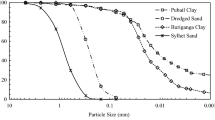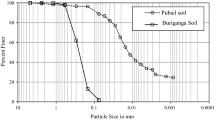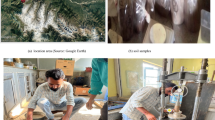Abstract
Vegetation has been used globally for centuries to control soil erosion on slopes. It is widely recognized that vegetation contributes to slope stability, but to an unquantifiable degree. Vetiver grass (Chrysopogon zizanioides) is being utilized to reduce the soil erosion and strengthen the slopes. Vetiver roots are massive, fine-structured, and grow fast and deep. With an average tensile strength of 85 MPa, which approximates to one-sixth of that of mild steel, Vetiver root is compared to as ‘living soil nail’. Roots of trees and other vegetation increase the shear strength of soil by root reinforcement. The difference between shear strength values of root-permeated soil and root-free soil sheared under the same conditions gives the shear strength increase caused by the roots. This paper presents the investigation on increase in shear strength of soil by Vetiver roots. Using a custom made large-scale in situ direct shear test apparatus, in situ direct shear tests were conducted at different depths on a soil plot with one-year-old Vetiver grass planted at 0.15 m spacing in an equilateral triangular pattern. The tests prove that the Vetiver grass roots increase the shear strength of soil by up to 139% at 0.15 m depth and up to 47% at 0.75 m depth.
Access provided by Autonomous University of Puebla. Download conference paper PDF
Similar content being viewed by others
Keywords
1 Introduction
On July 30, 2014, a landslide occurred in the village of Malin in Maharashtra killing at least 151 people. Major cited cause for the landslide was excessive deforestation in that area. Deforestation not only removes trees but also the root structures that hold the soil. Slope failures affect and disrupt transportation routes, urban development, mining and timber harvesting operations. These activities are very often themselves a major cause for slope failures.
The use of vegetation as a bioengineering tool for erosion control and slope stabilization has been implemented for centuries and its popularity has increased remarkably in the past few decades. The cost-effectiveness and environment-friendliness of this bioengineering approach have greatly increased it cachet.
Vetiver grass has been used by Indian farmers for over 200 years mainly for soil and water conservation. However, its real impact on slope stabilization and soil erosion control started in the late 1980s following the promotion of Vetiver system by the World Bank.
The biological name of Vetiver grass is Chrysopogon zizanioides. Vetiver is most closely related to sorghum, but shares many morphological characteristics with other fragrant grasses, such as lemongrass, citronella and palmarosa. Vetiver is native to tropical and sub-tropical India. Vetiver plant can be grown over a very wide range of climatic and soil conditions, and if planted correctly can be used virtually anywhere under tropical, semi-tropical, and Mediterranean climates. Vetiver’s physiological traits make it tolerant to extreme climatic variations such as prolonged drought, flood, submergence, fire, frost, and heat waves. It is also tolerant to a wide range of soil acidity, alkalinity, salinity, sodicity, agrochemicals and elevated levels of heavy metals in the soil.
Unlike most grasses which spread roots horizontally, Vetiver roots grow vertically downward up to 2–4 m in depth. Depending on the soil conditions, the roots can grow up to 3 m within the first year of planting. Vetiver roots possess very high tensile strength which varies between 40–180 MPa. The unique property of resilience along with deep and strong roots makes Vetiver an ideal plant for use in soil bioengineering applications.
The purpose of this investigation is to quantify the increase in shear strength of soil due to Vetiver roots. Accurate information about the quantitative effects of roots on soil strength is necessary to guide the design and management of Vetiver systems.
2 Literature Review
The role played by vegetation in enhancing soil stability is found in several publications (e.g., Greenway 1987; Gray and Leiser 1989; Coppin and Richards 1990; Gray and Sotir 1996). In a direct mechanical sense, vegetation increases the strength and competence of the soil by root reinforcement. A root-permeated soil behaves as a composite material in which fibers of a relatively high tensile strength are embedded in a matrix of lower tensile strength. Some of the most promising studies of roots as soil reinforcement have been direct measurement with empirically applicable results, either on a qualitative or quantitative basis. These include laboratory shear tests of soils with roots (Waldron 1977), and in situ shear tests on soil blocks with roots (Nilaweera 1994). These studies produced data that show increase in shear strength due to soil-root interaction and describe functional relationships and characteristics that influence the reinforcement phenomenon.
Several researchers agree that the effect of roots is to provide an increase in the effective cohesion of the soil (Gray and Ohashi 1983; Sotir and Gray 1989). Coppin and Richards (1990) have stated that the magnitude of the mechanical reinforcing effect of plant roots is a function of density, tensile strength, tensile modulus, length/diameter ratio, surface roughness, alignment, and orientation.
Perhaps the most complete overview of soil reinforcement by roots and artificial fibers is provided by Gray and Sotir (1996). The basic process involves the transfer of shear stress within the soil to tensile resistance of the roots, which becomes a function of the interface friction along the root surface. The orientation of the fiber relative to the shear force, the skin friction of the root, the elongation behavior of the root, the fraction of the soil cross-section occupied by roots, and the tendency to break rather than pullout are all factors influencing the reinforcing effect. Direct shear tests have been conducted in laboratory as well as field settings to evaluate performance of mainly woody plants and various fibers designed to simulate roots.
Endo and Tsuruta (1969) and Ziemer (1981) conducted in situ direct shear tests on root-permeated soils. Their results show an approximately linear increase in the root cohesion with increasing root biomass. Laboratory tests conducted by Gray and Sotir (1996) in root-permeated soils show a similar relationship. Test results for hardwood trees obtained by Nilaweera (1994) show an increase in shear resistance values. Hengchaovanich and Nilaweera (1996) conducted soil block shear test on two year old Vetiver hedges and found increase in soil strength.
Experimental research data that quantitatively address the soil reinforcement contribution of Vetiver plants have been scarce to date. In addition, there is a wide range of soil strength data depending on sample size, spacing of planting, age of plant and condition of root.
3 Soil Properties
The study site is located in Hemavathi Estate in the village of Niduvale, of Mudigere Taluk in Chikmagalur District of Karnataka in India. The GPS coordinates of the site are 13° 10′ 28.7″N 75° 29′ 43.1″E. The site is 1047 m above the mean sea level. The soil properties of the study area are shown in Table 1.
4 Tests and Methodology
The reinforcing effect on the increase of shear strength of soil due to roots can be quantified by conducting in situ direct shear tests on root-permeated and root-free soils at the same location. The difference between shear strength values of root-permeated soil and root-free soil sheared under the same conditions gives the shear strength increase due to the roots. In order to determine the root reinforcement effect of Vetiver grass, large-scale in situ direct shear tests were performed on a soil vegetated with Vetiver. Locally sourced South Indian genotype Vetiver was planted at 0.15 m spacing in equilateral triangular pattern on a level ground. The tests were conducted after one year of planting. The tests were conducted with the shear plane at different depths. The tests were conducted on saturated soil by flooding the site for 96 h prior to testing. The average tensile strength of Vetiver roots was 85 MPa.
The principle of in situ shear testing is described in BS 5930 and IS 7746 (1991). However, this system has mainly been developed for in situ testing of rock but not for root-reinforced soil. A number of researchers have therefore devised and developed in situ shear testing apparatus for this purpose. The first reference to in situ testing of root-reinforced soil was Endo and Tsuruta (1969) who designed the apparatus to measure the contribution of small Alnus glutinosa roots to the strength of homogeneous nursery soil in Japan. O’Loughlin (1972) later used a slightly modified design for the study of old-growth forests of coastal British Columbia, Canada. Endo reused his shear apparatus in 1980 to measure the strength of Betula japonica and Alnus japonica tree roots.
In this study, a custom-made large-scale in situ direct shear test apparatus was developed to conduct in situ direct shear test. The apparatus comprised of 30 cm × 30 cm shear boxes along with a reaction frame, screw jack, proving ring and dial gauges. The height of the lower shear box was 15 cm and the height of the upper shear box was equal to the depth of shear plane from the ground level. The height of the upper shear box was varied depending on the depth of the shear plane. The lower shear box has a sharpened cutting edge. The two shear boxes were stacked up driven into the ground planted with Vetiver. A relatively undisturbed soil-root sample gets transferred into the shear box. The soil surrounding the shear box was removed. By using a reaction frame, the lower shear box was restrained against any lateral movement. The upper shear box was sheared horizontally under strain controlled condition at a rate of 1 mm/min. The shear load and shear deformation were noted at every 30 s interval. A pair of guide rollers was used to prevent twisting and tilting of shear boxes. The guide rollers guide the shear box along the direction of shear load without twisting and tilting. After failure, the shear surface and the orientation of failed roots were examined carefully in order to study the failure pattern. The total cross-sectional root area on the shear plane was measured to determine the root area ratio. The same procedure was repeated to conduct tests by increasing the depth of shear plane. Tests were conducted at every 0.15 m interval up to a total depth of 1.20 m. For each depth level of shearing, a root-free soil profile adjacent to the root-permeated soil profile was also sheared under the same shearing conditions. Each soil block was sheared under its own self-weight as the normal load. A stress–strain variation with depth is plotted for both Vetiver-rooted and non-rooted soil.
Figure 1 shows the schematic diagram of the in situ test apparatus developed. Figure 2 shows the actual in situ direct shear test being conducted on field with Vetiver plants being planted at 0.15 m spacing.
5 Results and Discussion
The stress–strain plots of in situ direct shear tests conducted on non-rooted and Vetiver-rooted soils are shown in Figs. 3 and 4, respectively.
Figures 3 and 4 show that shear strength of Vetiver-rooted soil is higher than non-rooted soil. Compared to non-rooted soil, Vetiver-rooted soil exhibits very large strain prior to failure. Large strain leads to progressive failure which would provide sufficient warning before landslides.
Table 2 shows that the peak shear strength of Vetiver-rooted soil is higher than that of non-rooted soil. An increase of up to 139% can be observed at a depth of 0.15 m. The increase in shear strength is directly proportional to the root area ratio (RAR). The increase in strength is greatest at shallow depths due to high root area ratio and reduces when root area ratio reduces with depth. While conducting tests it was also observed that at shallow depth, the roots failed primarily by slippage. With increasing depths, the roots failed by root breakage.
6 Conclusions
The in situ direct shear tests show that the Vetiver roots increase the shear strength of soil by root reinforcement. The increase in strength is dependent on root area ratio, which depends on soil and climate conditions.
The increase in shear strength is limited by the depth of roots and thus the root reinforcement by Vetiver is useful only to shallow depths.
References
Coppin, N. J., & Richards, I. G. (1990). Use of vegetation in civil engineering. London: Butterworth.
Endo, T., & Tsuruta, T. (1969). The effect of tree roots upon the shearing strength of soil. Annual Report of the Hokkaido Branch, Tokyo Forest Experimental Station, 18, 168–179.
Gray, D. H., & Leiser, A. T. (1989). Biotechnical slope protection and erosion control. New York: Van Nostrand Reinhold.
Gray, D. H., & Ohashi, H. (1983). Mechanics of fiber reinforcement in sand. Journal of Geotechnical Engineering, ASCE, 109(3), 335–353.
Gray, D. H., & Sotir, R. B. (1996). Biotechnical and soil bioengineering slope stabilization. New York: Wiley.
Greenway, D. R. (1987). Vegetation and slope stability. In M. G. Anderson & K. S. Richards (Eds.), Slope stability (pp. 187–230). New York: Wiley.
Hengchaovanich, D., & Nilaweera, N. S. (1996). An assessment of strength properties of vetiver grass roots in relation to slope stabilization. In Proceedings, First International Vetiver Conference (pp. 153–158), Thailand.
Nilaweera, N. S. (1994). Effects of tree roots on slope stability: The case of Khao Luang Mountain area, southern Thailand. Doctor of Technical Science Dissertation. Thailand: Asian Institute of Technology.
O’Loughlin, C. L. (1972). An investigation of the stability of the steep land forest soils in the coast mountains, southwest British Columbia. Ph.D. dissertation. Canada: University of British Columbia.
Sotir, R. B., & Gray, C. H. (1989). Fill slope repair using soil bioengineering systems. In Proceedings, 20th International Erosion Control Association Conference (pp. 473–485), Vancouver, BC, February 15–18, 1989.
Waldron, L. J. (1977). The shear resistance of root permeated homogeneous and stratified soil. Soil Science Society of America Journal, 41, 843–849.
Ziemer, R. (1981). Roots and shallow stability of forested slopes (pp. 343–361). International Association of Hydrological Sciences, Publication No. 132.
Author information
Authors and Affiliations
Corresponding author
Editor information
Editors and Affiliations
Rights and permissions
Copyright information
© 2019 Springer Nature Singapore Pte Ltd.
About this paper
Cite this paper
D’Souza, D.N., Choudhary, A.K., Basak, P., Shukla, S.K. (2019). Assessment of Vetiver Grass Root Reinforcement in Strengthening the Soil. In: Thyagaraj, T. (eds) Ground Improvement Techniques and Geosynthetics. Lecture Notes in Civil Engineering , vol 14. Springer, Singapore. https://doi.org/10.1007/978-981-13-0559-7_15
Download citation
DOI: https://doi.org/10.1007/978-981-13-0559-7_15
Published:
Publisher Name: Springer, Singapore
Print ISBN: 978-981-13-0558-0
Online ISBN: 978-981-13-0559-7
eBook Packages: EngineeringEngineering (R0)








